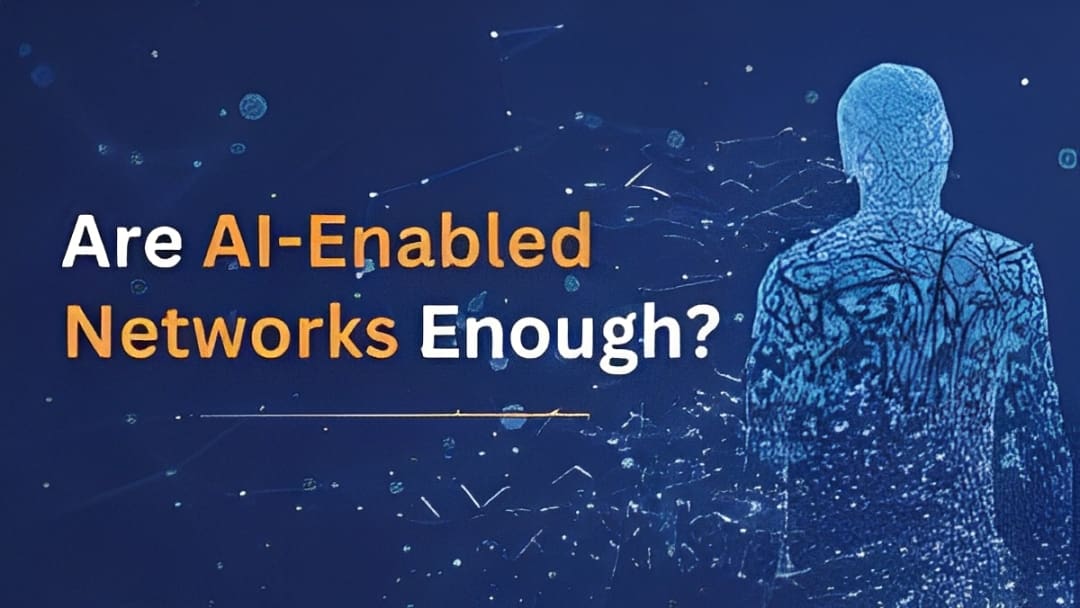Understanding Core Components and Capabilities
One thing I’ve learned over the years is that technology is always evolving. I’ve often told my colleagues and friends, “I used to say I’d have to reinvent myself every five years, but now it’s happening every two.” What’s driving this accelerated change? Creative technological innovations. Also, I’m seeing how things like better networking capabilities, more organizations using cloud computing, and the sheer volume of data created daily are really challenging traditional IT approaches. Many clients have sought my opinion on AI and AI-powered solutions, particularly concerning networking solutions and overall cybersecurity posture. It’s a frequent topic because companies are trying to handle networks that are getting more complicated, make sure things run smoothly whether they’re using the cloud or their own gear, and get better at stopping security threats – and AI looks like it could help with all that. While I believe these advancements can help organizations achieve more with fewer resources, I also advise exercising caution. It’s not a simple fix, and implementation requires careful consideration of your existing IT environment, including on-premise data centers, cloud services, or a combination of both. No matter the vendor, most AI-enabled networks tend to incorporate the following components:
Machine Learning: A branch of artificial intelligence that leverages algorithms to build models and analyze large volumes of network and operational data (often housed in cloud storage or processed within data centers), enabling machines to perform tasks that were once exclusive to humans. Essentially, it’s the ability to make predictions (or provide answers) based on the data it has processed. Think of it as advanced pattern recognition on steroids. How well it works really depends on getting good, clean data for it to learn from.
Deep Learning: A subset of machine learning and a key element of data science. It powers applications and services that enhance automation, allowing systems to perform both analytical and physical tasks without human intervention. Deep learning often demands substantial computing resources, frequently utilizing specialized hardware within modern datacenter architecture or scalable cloud infrastructure services.
Natural Language Processing (NLP): A field of artificial intelligence that employs machine learning to enable computers to comprehend and interact using human language. In network operations, this could involve interpreting user-submitted support tickets or understanding voice commands, potentially streamlining interactions with managed IT support.
Generative AI: A form of artificial intelligence that allows machines to generate content in response to prompts. This can include text, images, video, audio, or even software code. We’re starting to see tools where Generative AI can suggest network configurations, draft incident summaries, or generate scripts for network automation, which could help speed up certain tasks.
Autonomous Network: A new AI-driven network model that is self-managing and self-healing, requiring minimal human involvement. The goal is to create a self-regulating network that delivers greater efficiency, performance, and reliability, reducing costs and minimizing human error. Achieving this level of autonomy typically involves integrating data from various AI components to proactively adjust network operations and enhance network security. Key pillars of such networks are typically: Sense, Think, and Act.
What I want to emphasize is that these advanced AI capabilities rely on a solid technological foundation. This includes the network infrastructure itself, any supporting cloud infrastructure, the data center environment (physical or virtual), and sound cybersecurity principles applied from the outset. Without this solid base, even sophisticated AI tools might not achieve their full potential.
The common objective I hear is that AI-enabled network solutions should make networks more intelligent, self-adaptive, efficient, and reliable. Manufacturers claim that an AI-enabled network can dynamically adjust workloads based on real-time data, ensuring optimal performance even during periods of high demand. The phrase I commonly hear is “Autonomous Networks” as the ultimate goal (though I have yet to see a solution that is fully there), or “AI-Powered Network Operations.” Is this adaptability a game-changer for managing the constantly shifting needs of modern applications and services, especially those deployed across mixed environments (often referred to as hybrid cloud)? If it performs as advertised, absolutely.
The Role of Data and Limits of AI in Network Operations
One key lesson I’ve learned about AI is that its accuracy depends heavily on the data it processes and the selection of the right data models for decision-making. Many people don’t realize that training an AI model to make informed decisions can take time, which is why there are so many AI-enabled products. Think of AI-enabled network operations as pre-trained models, similar to the popular version of AI (v2, v3, v4) in the market today. With each version of AI, it improves based on the data it has ingested, creating a more refined product with every iteration.
What are the “limits” of what AI can do on the network? That’s a great question, and although I dislike saying this, the answer is often, “it depends.” However, what I can say for now is that AI’s capabilities are mostly focused on network operations. As AI becomes integrated into enterprise network solutions, several dependencies must be considered. These dependencies often extend across your entire IT infrastructure, involving core systems and data security practices. Addressing potential challenges frequently requires thoughtful planning, which might include strategic cloud migration projects or updates to the existing datacenter architecture. These include, but are not limited to:
– Manufacturer/Product capabilities
– Existing Infrastructure (including on-premise data centers and cloud computing environments)
– Version or Generation of AI model/Platform
– Compatibility & API (especially with cloud services and other critical applications)
– Your comfort & level of trust
– Data Collection/Accuracy of Data (and the security measures protecting that data)
As stated above, most AI-enabled networks primarily focus on network operations and automation. For example, consider a scenario where users are experiencing issues with “time-sensitive apps” crashing on the network. Based upon the “Machine Learning” module, the AI may be able to recognize common variables that are causing this (such as ports not configured correctly), then utilize the “Deep Learning” module to correct this issue, then use the “NPL” module to create/update a ticket as to what the issue was and how it was resolved, then finally use the “Generative AI” module to ensure that an initial check is done so that anything that applies to this situation doesn’t happen again. In many organizations, this degree of automation functions best when supported by efficiently managed IT support processes.
An important factor to consider in this example is, what happens if the data isn’t accurate?
The Impact of Inaccurate Data on AI-Enabled Networks
Lets explore the Data Accuracy question. If you follow me on LinkedIn, you may remember a four-part series I wrote called: “Is Artificial Intelligence the Emerging Frontier?“. In that series, I discussed the potential of AI using the context of AI learning how to play Super Mario Brothers. I had a curious thought about AI and bad data that I decided to explore. So I restored the solution from my backups for this experiment and intentionally fed the AI incorrect or random data that had nothing to do with playing Super Mario Brothers. Unsurprisingly, as I kept inputting bad data or nonsensical information, the AI model struggled to perform. What happened was a series of odd or awkward movements, and in most cases, it couldn’t complete the level (the timer would run out). In a way, you can think of bad data in AI as technical debt; the more bad data it consumes, the less accurate and capable it becomes.
If bad data, such as mislabeled, unavailable, uncollected, or improperly polled data, enters the system, it could slow down the process or prevent the AI from identifying the issue entirely. This highlights the critical importance of strong data governance policies and robust data security measures, particularly when sensitive information might be distributed across various cloud storage platforms.
Someone might ask, “Wouldn’t the AI platform detect this and fix this automatically?” My initial thought is that the answer depends largely on your level of trust and comfort with the solution. If trust and comfort are in place, it could be possible. But does the AI solution have the necessary visibility, data, and authorization to make such decisions? Does it have secure access to the necessary cloud infrastructure or data center components?
When troubleshooting an issue or redesigning a network, what level of visibility would you require? This is a critical factor to consider when architecting an AI-enabled network solution. Another key consideration is which APIs from network-connected devices should be integrated into the solution. Many devices, such as compute, storage, applications, appliances, IoT devices and desktop applications come with APIs that allow for integration. Often, these integrations span hybrid cloud environments, adding another layer of complexity. I recommend having a structured discussion with your trusted technical advisor or perhaps an IT consulting services firm to ensure that, when the time comes, you have a clear understanding of what this could or should look like and what the potential use cases are. This conversation might also cover aspects of IT procurement related to necessary hardware or software investments.

Securing AI-Enabled Networks: Key Steps and Considerations
How do you approach network security and the broader cybersecurity challenges associated with an AI-enabled network? This is a challenging question, and I may not be able to fully answer it without more context, but I can offer some high-level guidance and considerations. I’ve shared a few posts on security on KNZ’s website and LinkedIn. At the end of the day, AI is still an application with dependencies. Most AI-enabled applications require high-speed connections to their dependencies to function, but not necessarily to the devices they pull data from. A good starting point would be to create a dependency map, identifying what the AI-enabled network application connects to, whether those resources reside in your local datacenter, a private cloud, or public cloud services.
A useful approach to consider is the principle of least privilege or even a minimal version of zero trust. It’s important to keep in mind that if an AI-enabled network solution is compromised, serious issues could arise. As I often advise, begin by defining the problem statement or scenario and work backward from there. This is a solid strategy to ensure your organization is taking the necessary steps to secure any environment. Investing in effective cybersecurity solutions and potentially partnering with a managed security service provider (MSSP) or specialized cybersecurity company can be very beneficial, especially with the evolving threats targeting AI capabilities. These cybersecurity services often provide specialized knowledge in areas like cloud security which can be difficult to develop solely in-house.
For example, imagine that an AI-enabled network solution gets compromised and some parameters are altered, resulting in the system ingesting false data, such as information pointing to the CEO of the organization. This could serve as an effective distraction while intellectual property is being stolen, and the organization might not notice until it’s too late. How could you mitigate this risk? In addition to relying on the partner or manufacturer of the solution, here are a few steps to consider:
– Ensure data integrity and data security through regular validation and monitoring
– Restrict access to critical parameters within the platform
– Implement secure access controls to the platform (leveraging strong authentication and cloud security best practices where applicable)
– Limit wherever possible what the AI-enabled solution can access/change.
Remember, when it comes to cybersecurity, we all play a role in safeguarding our solutions. It’s essential not to solely rely on the manufacturer or partner to secure the environment; using a multi-layered cybersecurity strategy is generally much more effective.
Returning to the question posed in the title: Are AI-enabled networks enough? In my opinion, not quite yet. They still require human intervention. However, implementing AI-enabled network solutions can pave the way for future autonomous networks and help address current network issues. To illustrate this, think of an AI-enabled network as a Tier 1 support agent. As the agent gains experience and knowledge, they progress to higher roles in their career. I believe the same is true for AI. Just as a Tier 1 support agent isn’t perfect, neither is AI, but with time and data, it will improve. As our understanding of data and analytics advances, AI-enabled solutions will continue to evolve and become more powerful, leading to more transformational events on networks.
For example, imagine a user needing help with an application issue. They could open an AI-enabled network chatbot, describe the issue in plain language, and have it resolved in real-time. Could this happen today? Possibly. Will it happen in the future? Absolutely. And while we look towards that future, it brings us back to the practical steps needed today. Understanding your own organization’s position on this path is something I strongly advise before diving deeper into AI adoption. To assist with that important self-assessment, I encourage you to take our AI-Readiness Quiz. It’s designed to provide a clearer picture of your current readiness and perhaps illuminate areas worth considering as you navigate the evolution towards more intelligent network solutions.
About the Author:

Chris Price is an experienced executive deeply committed to nurturing and empowering team members to realize their fullest potential. My passion lies in technology thought leadership, and my career has been dedicated to providing guidance and leadership in aligning technology with business objectives. In recent years, we’ve observed a significant evolution in technology, particularly in digital solutions, which have the potential to differentiate businesses and confer a competitive advantage in their respective industries. In this new era of digital business, organizations must embrace transformation. Within my team, we possess the expertise to guide organizations through the disruptions brought by digital innovations, offering innovative ideas and state-of-the-art technology to navigate these changes effectively.





